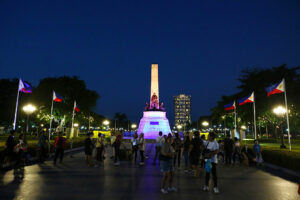3D and beyond

Action for Economic Reforms (AER) has been piloting its data-driven development (3D) program in the Philippines since 2020, with the support of both the US Agency for International Development (USAID) and the European Union (EU). Over the past two-and-a-half years, AER has gained valuable insights and experiences from the implementation of two successful projects, which have demonstrated the potential of data-driven approaches to catalyze development in the country.
As the EU project ended in 2022 and the USAID project is soon to close out in 2023, it is crucial for AER to reflect on the achievements and challenges and chart a sustainable way forward. This essay outlines four initiatives for expansion. In each, we explain the problems and how we tried to solve them through the 3D program and identify the opportunities for sustainability and expansion. With this program, AER aims to build on its achievements and expand its advocacy for the use of data to achieve inclusive and sustainable development in the country.
FROM KILOGRAMS TO KILOBYTESPROBLEM: In a typical local government office, kilograms of data are being created each month in paper form. Government workers, on top of their already busy work schedules, also have to encode this data. This inefficient process starting from paper-based data collection, not only requires manual encoding, but also increases the risk of human error which can lead to low-quality data. It takes months before data from the barangay or municipality reaches the provincial, regional, then national offices. This protracted process leads to delayed reports and policies, making them less effective in addressing current issues. This anecdote highlights the urgent need for digital transformation in the Philippines, particularly in local government units (LGUs), to improve the efficiency and accuracy of data collection and to ensure that policies are timely and effective in addressing the needs of the community.
SOLUTION: AER’s 3D programs introduced digital data collection to the 14 partner sites in Luzon, Visayas, and Mindanao. After the two-year project, LGUs saw a significant improvement in the perception towards their capacity in data collection. This is based on the baseline and endline surveys run by AER. There was approximately a 10% increase in respondents reporting that they agree or strongly agree with having improved perceptions of their data collection capacity.
Based on the report by the external evaluator, LGUs said that they implemented digital data collection beyond the initial focus sectors in the project and managed to share the practice with other departments and offices. This is unsurprising given the well-attended capacity building activities on digital data collection, and the clear benefits digital data collection yields to our local government partners. The session introducing digital data collection proved to be the most popular — with over 100 attendees — among all capacity building sessions held by the project.
OPPORTUNITIES: There are many opportunities for expansion and institutionalization of digital data collection. Firstly, we plan to coordinate with national-level agencies to streamline reportorial requirements and encourage digital data collection among LGUs. This leads to faster data collection and transmission, which can aid in the generation of timely reports and policies. Data generated should also be made consistent with the mandated datasets and reportorial requirements set by the national government.
Secondly, partnering with the Philippine Statistics Authority (PSA) to standardize survey questions and answers ensures that statistics can be triangulated among different sources, leading to more accurate and reliable data.
Thirdly, LGUs can avoid redundancies in collection by integrating administrative and survey data from various sources to generate a more complete database.
Finally, to institutionalize digital data collection, specialized courses can be developed and offered by State Universities and Colleges (SUCs) to students, government workers, or other interested parties, leading to a better understanding of digital data collection and analysis.
PUTTING 3D ON THE MAPPROBLEM: Despite the importance of geospatial data for informed policymaking, LGUs in the Philippines lack such data. According to ThinkingMachines, only 40% of the Philippines has been mapped (2020). This leaves many critical facilities and infrastructures unseen, rendering people and places invisible. Incorporating geospatial analysis into policymaking puts people and their communities on the map — both literally and figuratively.
SOLUTION: The 3D program promoted mapping through OpenStreetMap (OSM) to its partner sites. OSM is a free, open, and crowd-sourced mapping platform where volunteers can contribute and edit geospatial data.
Through the help of local partners, student organizations, and other volunteers, OSM was widely applied to a variety of sectors: tourism, health, disaster management, transportation, and more. For example, in partnership with Pasig Transport, over 1,228 points of interest were mapped, including foot bridges, wheelchair ramps, crossings, parking and public transportation stops and stations. Other sites prioritized different sectors, such as mapping homestays in Donsol, educational institutions in Arteche, and business and tourist establishments in Palimbang. Ultimately, OSM became a platform for collecting geospatial data for and by the local communities.
OPPORTUNITIES: Mapping through OSM has the potential to make a significant impact on how policymakers and citizens visualize the community where they belong. However, there are still many areas where mapping can be further expanded to realize its full potential. One way to do this is to develop a course with SUCs to teach mapping with OSM and geospatial analysis. Second, it is important to encourage the formation of OSM youth organizations within SUCs or other volunteer groups in each local community. This will help build a network of mapping enthusiasts who can collaborate on mapping projects and share their expertise with others. Finally, an ambitious campaign of mapping the whole Philippines can be launched, which will help make the invisible, visible. By mapping areas that have previously been overlooked or neglected, we can identify and address issues of social and economic inequality, and ensure that the benefits of policies, as seen through mapping, are distributed more equitably across the country.
RESEARCH DATA CENTERSPROBLEM: In the Philippines, a lot of data collected for various objectives (i.e., reportorial requirements) often goes unused. This is a significant waste, as data is a valuable resource that can inform decision-making, policy formulation, and program planning. The failure to utilize data means that opportunities to address critical issues, such as poverty, health, education, and environment, are missed. It is crucial that data is not only collected but also utilized to inform evidence-based policy decisions, as this will enable local governments to address their priorities and improve the well-being of their constituents.
SOLUTION: Research Data Centers (RDCs) are secure facilities that provide qualified researchers access to restricted-use microdata from surveys and censuses conducted by the Philippine Statistics Authority and other high-quality data from other national government agencies, local government units, and other organizations. RDCs are designed to facilitate research on various topics ranging from agriculture, labor markets, education, health, and other areas of social, economic, and demographic research. In the Philippines, there is a growing demand for microdata that is used to promote data-driven and evidence-based research and policy.
OPPORTUNITIES: SUCs are ideal settings for RDCs because of their mandate of research and extension and the high technical capacity of their academic personnel. SUCs also have a campus presence in almost every province and most cities and municipalities, which makes them accessible to a wide range of users, including faculty members, students, government agencies, and civil society. Through the establishment of RDCs, SUCs can encourage the usage of high-quality data, which will help mainstream the use of evidence-based policymaking. As the demand for high-quality data increases, the supply of data-driven decision-making likewise increases. This can only be done in partnership with SUCs, various national and local government units, and other stakeholders.
LEGISLATION FOR INSTITUTIONALIZATIONPROBLEM: In the Philippines, the prevailing culture in governance is doing what has been done before (nakasanayan), regardless of whether it works or is the best possible solution. This is grounded in a lack of appreciation for the role of data in development, as echoed by a local chief executive who admitted that “we have data, but we never use them.” Legal initiatives (e.g., Data Privacy Act) have also contributed to a climate that is averse to open data, creating a culture that promotes keeping data for oneself even if it means not being able to maximize its use.
SOLUTION: Because appreciation for data is not intrinsic in the culture of governance in the Philippines, legislation must be put in place to institutionalize data practices and build this culture of data-reliance. The 3D program has pioneered some initiatives towards this end, being instrumental in the passage of the following resolutions and executive orders: a.) Adopting the dashboard to share data, use and enhance it to make decision-making in the LGU and whole municipality more data-driven; b.) Designation of a data privacy officer of the LGU; c.) Creating the right to information technical working group; and, d.) Resolution to mainstream 3D in regional and local development planning, budgeting and investment programming. These were drafted and passed within the project period, with the hopes of eventually building and solidifying the culture of 3D.
OPPORTUNITIES: The low-hanging fruit is to share the existing data-related ordinance templates and make these widely available with other local government units and other organizations. Another initiative is to ensure the implementation of the Community Based Monitoring System (CBMS) Act which requires a local statistician in each city and municipality. Given the nascent stage of the CBMS act and the potential fund inflow from the Mandanas Ruling, there is a significant opportunity to make sure that all LGUs have a data officer or statistician. Other possible legislative proposals include a.) data sharing between national and local governments, and a b.) national evaluation policy. The former would address current obstacles in data sharing within and across offices, departments and agencies, and the latter would encourage the need for properly measuring and monitoring the benefits/costs of public policies and programs.
GOOD DATA, BETTER POLICIES, BEST LIVESPROBLEM: Good data, whether in kilobytes, maps, or through data centers, only serves as a means to a more fundamental objective: human and societal development. In many cases, data or technology is seen as an end in itself. On the one hand, policymakers and local government units think that data should be collected because it is mandated by law, or that reports need to be submitted because they are required by the national government. On the other hand, some multilateral organizations, members of civil society, and academics mistake data sophistication (e.g., machine learning, artificial intelligence, etc.) as essential for evidence-based policymaking. The challenge is to make data more useful and relatable to the actual beneficiaries and their communities — and not just for the sake of requirements or complexity.
SOLUTION: AER has learned that the needs of local governments and other stakeholders are much more basic than the sophisticated tools popular today. Through the 3D program, we pioneered the community mobilization activity, which as the name suggests, aims to mobilize members of the community (a coalition that includes the local government, civil society, and the state university/college) to collect data for a specific sector, towards the design and execution of a particular program or policy. In Tolosa, the local coalition digitized the PhilHealth enrollment form and registered more than the targeted new members into the public health insurance system. Digitizing made data collection faster, more reliable, and more policy ready. Immediately, new registrants were given PhilHealth cards as proof of enrolment.
OPPORTUNITIES: 3D is about championing the use of data for evidence-based policymaking. In our experience, this is best concretized through the community mobilization activities, which are easily scalable from one barangay to the entire municipality, and from one municipality to the province. Community mobilization epitomizes data of, by and for the people: local coalitions generating good data to produce better policies that lead to the best lives possible for all Filipinos.
Laurence Go is a trustee and senior fellow of Action for Economic Reforms. He coordinates AER’s data-driven development program.




